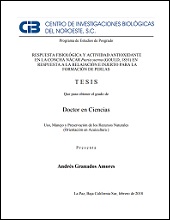Respuesta fisiológica y actividad antioxidante en la concha nácar Pteria sterna (Gould, 1851) en respuesta a la relajación e injerto para la formación de perlas
Author
ANDRES GRANADOS AMORES
Metadata
Show full item recordAbstract
"The physiological response (spontaneous spawning, glycogen metabolism and acid mucopolysaccharides secretion), enzymatic activity (superoxide dismutase, catalase and glutathione peroxidase) and oxidative damage (concentration of TBARS by lipid peroxidation and lipofuscin accumulation) associated to pre-operative (collection, transportation, acclimatization and relaxation) and operative stages (implantation and grafting) of pearl culture were assessed in the winged pearl oyster Pteria sterna. Two trials were conducted: the first one assessing the relaxation process, and the second one the grafting process. Previous to the first trial, the overall condition of oysters was evaluated during collection, transportation, and acclimation by sampling of tissue samples (mantle, gills, muscle, gonad, digestive gland, and connective tissue). Four relaxants were tested, each one at two different concentrations: magnesium chloride (15 and 30 g L–1), eugenol (0.25 and 0.5 mL L–1), phenoxy propanol (1.5 and 2.5 mL L–1) and benzocaine (0.15 and 0.25 g L–1). A subset of oysters not exposed to relaxants was kept as a control group. After the expose of oysters to each relaxant, samplings were conducted at 30, 60, and 120 min to collect body tissues (gonad, digestive gland, muscle, mantle and gills). The recovery process of oysters was assessed until 65 h after their exposure to each relaxant. The muscle was the only tissue where glycogen index significantly decreased between collection and transportation samplings. No significant variation in the mucopolysaccharide index was observed between sampled tissues. During the relaxation trial, the best relaxing effect occurred with benzocaine (0.25 and 0.5 g L–1) and phenoxy propanol (1.5 and 2.5 mL L–1), promoting more than 60% relaxation within the first 45 min. Spontaneous spawning events occurred in oysters exposed to 0.25 g L–1 benzocaine (62.5%) and 2.5 mL L–1 phenoxy propanol (56.3%), between 30-120 min exposure. The incidence of spontaneous spawning was 0% in the control group. The glycogen index in the digestive gland significantly increased in oysters exposed to 30 g L–1 magnesium chloride at 30 min and 0.25 g L–1 benzocaine at 60, 120 min and 65 h, suggesting utilization of glycogen reserves to cover other physiological needs, such as response to oxidative damage..." "En el presente estudio se evaluó la respuesta fisiológica (desoves espontáneos, movilización de glucógeno, secreción de mucopolisacáridos ácidos), actividad enzimática (superóxido dismutasa, catalasa, glutatión peroxidasa) y daño oxidativo (concentración de TBARS por peroxidación de lípidos y acumulación de lipofuscinas) asociada a las etapas pre-operatoria (recolecta, transporte, aclimatación y relajación) y operatoria (injerto de manto) en adultos de la concha nácar Pteria sterna. Se realizaron dos bioensayos; el primero enfocado al proceso de relajación y el segundo al proceso de injerto. En el primer bioensayo se realizó una evaluación previa del estado de los organismos durante la recolecta, traslado y aclimatación, a partir de muestras de tejidos (manto, branquias, músculo, complejo gónada-glándula digestiva, tejido conjuntivo). Se evaluaron cuatro relajantes, cada uno a dos concentraciones: cloruro de magnesio (15 y 30 g L–1), eugenol (0.25 y 0.5 mL L–1), fenoxipropanol (1.5 y 2.5 mL L–1), y benzocaína (0.15 y 0.25 g L–1). Se incluyó como control un grupo de organismos sin relajación. Posterior a la exposición de las ostras en cada relajante, se realizaron muestreos a los 30, 60 y 120 min, recolectando muestras de tejidos (gónada, glándula digestiva, músculo, manto y branquias). También se evaluó el proceso de recuperación de las otras hasta las 65 h posteriores a su exposición en cada tratamiento de relajación. Se incrementó el índice glucídico en el músculo en el muestreo de campo y disminuyó durante el transporte. No se observaron variaciones significativas en los valores del índice de mucopolisacáridos en ninguno de los tejidos muestreados. Durante el bioensayo de relajación, el mejor efecto relajante se obtuvo con benzocaína (0.25 y 0.5 g L–1) y fenoxipropanol (1.5 y 2.5 mL L–1), los cuales promovieron más del 60% de relajación en los primeros 45 min. Se observaron desoves espontáneos en organismos tratados con benzocaína a 0.25 g L–1 (62.5%) y fenoxipropanol a 2.5 mL L–1 (56.3%) entre los 30-120 min de exposición. La incidencia a desoves en el grupo control fue 0%. En la glándula digestiva, el índice glucídico se incrementó significativamente en los organismos relajados con cloruro de magnesio (30 g L–1) a los 30 min y con benzocaína (0.25 g L–1) a los 60, 120 min y 65 h, sugiriendo que las reservas de glucógeno son utilizadas para cubrir otras necesidades fisiológicas como la respuesta de protección frente a un posible daño oxidativo..."
Collections
Related items
Showing items related by title, author, creator and subject.
-
PROMOCIÓN DEL PERIFITON PARA EL CULTIVO DE CAMARÓN BLANCO: HACIA UNA ACUICULTURA ECOLÓGICA
DOMENICO VOLTOLINA LOBINA; JUAN MANUEL AUDELO NARANJO; MARIA DEL ROSARIO PACHECO MARGES -
Suelo y Erosión
YOLANDA LOURDES MAYA DELGADO


